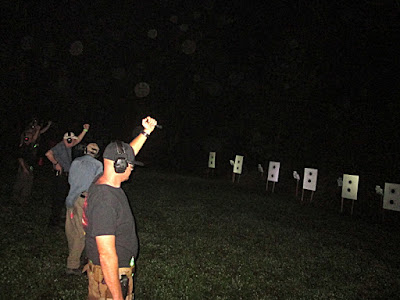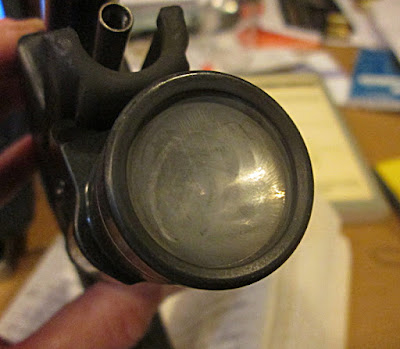I recently finished Rich Hart’s Low Light Pistol fighting class. Any misrepresentation is due to my faulty
understanding, but let’s dive in anyway.
I simply have to say it was a blast, very high in the CDI
factor. That’s "Chicks Dig It" factor.
Actually, I have have no idea if women actually dig it. What I wanted was skilled training about
handgun low light shooting and exposure to the current ideas and concepts. And that’s what I got.
When I first did low light training the Mag-Lite was the hot
ticket flashlight. Light Emitting Diodes
(LED) were toys and the idea of using them as a light was still science
fiction. Still, there is a lot to recommend
a 16-inch metal pipe that’s just a flashlight.
If you carry a Mag-Lite, let me recommend Peter’s "Defensive Tactics
Flashlight."
We started class with discussions and practice drills in the setting sun.
But back to Rich’s class.
All modern instructors give a safety/first-aid talk at the
beginning of each class. This includes
identification of any paramedics in the class or advanced first-aiders,
location of trauma kits and discussion of what has to be done. Rich did a very nice job with this.
I strongly recommend this; we have all heard horror stories
of dispatchers not understanding your emergency, calls going to the wrong dispatchers,
ranges not having a plan in place.
If you shoot, spend half a day in a first aid class for shooters and carry a personal trauma kit.
If you are prepared to take a human life, then you should be prepared to
help safe a human life, possibly your own.
The class then settled into discussion of tools and what we
want to accomplish. Rich utilizes a
Socratic method of teaching in which questions are asked to stimulate critical
thinking.
This is a change up from many of my instructors who taught
rules. Teaching rules isn’t bad, but to
reach a higher level of understanding and utility, critical thinking is a must.
Here’s an example: I
have always subscribed to the concept of light off when moving. I have been taught this at several schools
and have taught it to my students. Let’s
pull it apart.
In an urban environment, most of your conflicts will have some
ambient illumination. Both you and Violent
Criminal Actor have some degree of visibility and turning your light off
doesn’t make you invisible. So what do
we want from a light?
Generally what we want from a light is to determine if shooting
that person is righteous or not.
We geared up and everyone wore a chem-light stick for safety. Some of the sticks looked like we should have been at a rave but it was all good. Note the forehead task light , it was very useful for filling mag and finding dropped equipment.
Think about that. In
the bar parking lot, at Walmart, or the street in front of your house there is
likely sufficient illumination to determine if a person is present, but perhaps
not enough to determine if there is a weapon in their hands. That’s the advantage of light.
By questioning what we want from a light and what we want to
gain from turning it off allows a new paradigm to surface: Leave the weapon/hand-held light on.
With this idea I reexamined my previous training. I realize it was geared to no light
situations in dark warehouses, dark houses, hallways and basements at night as
well as rural environments in no light conditions. Different conditions from what I am exposed
to in an urban and semi-rural environment.
So, now I’m thinking about moving with my light on.
The black tactical light is the Surefire Combat 6Z light. It was the hot, hot ticket when I started training. The shape and rubber rings lends itself to the cigar technique. It's plastic brother doesn't have the ring, so it works better for the Harries techniques. Equipment also drives tactics.
While concepts drive technique, it is also true that mission
drives gear. Few of us need SEAL
tactics, despite the fun of learning them.
We’re not likely to have to silently kill a sentry to rescue our child
or spouse. Nor does the legally armed
civilian need to close and handcuff a VCA.
Our task is different.
We should select the tools that assist us in accomplishing
our task. For most of us, that task will
be to stop any further harm and stabilize the situation until the professionals
arrive.
Lined up and using the old FBI mag-lite technique. It's a lot easier when you're not using a heavy steel body Mag-lite. The lighter tactical lights works well for this. As much as I liked it, I did notice a tendency to spend time aiming the light and not the pistol. Will training eliminate this? I don't know.
So we need to pick the right tools and tactics.
We spent a lot of time talking about tactical lights both
weapon-mounted and handheld. These
topics included what you want to do, what to consider, how bright and
ramifications of both. Take the course
to get the fine points, but let me go on the record, you want a lot of light
and a simple on/off. As with machine
guns, simple is better.
My 4Sevens light, now out of business. It has too many functions, but I selected on/off at high power and a second strobe/non-strobe function determined in advance at the bezel. I added the lanyard. If I was to investigate a noise at 0-dark thirty, I would set up the lanyard on my left wrist first, then investigate. Being able to "drop" the light to free the fingers is invaluable. The protective rim around the button makes this light hard to click on/off rapidly.
After a few drills it quickly became apparent that weapon lights
have limited functionality. Why?
Do you really want find your kid playing hide and seek in a
closet by pointing a gun at them? What
about doing a 360 scan after a shooting by pointing your gun at everyone and
everything behind you? Sounds like really
bad ju-ju to me. Solution? Hand-held lights.
Rich pointed out that it is very likely in low/no light
situations we’ll have a light in one hand when we discover we need a gun in the
other.
We practiced several non-support hand light techniques. One was the FBI mag-lite technique, which I
had dismissed years ago as hopelessly outdated but now utilize. Many of the students employed variations of
the Harries technique as well as the cigar or syringe technique. Several liked the controversial check or
temple weld technique.
Harries technique, thanks to the internet photo collection. There is a tendency to have the hands separate in recoil.
The cheek weld, if you are not familiar with it, is the Harries technique held against the jaw or temple. I’m still not sure about that one.
Again, stolen from the internet--- The cigar technique. I always find this results in a lot of things happening near the trigger. Again could be just my hands and technique.
Part of the message I got from Rich’s class was to evaluate each technique as a loss/gain in context of the current situation. Makes sense. Maybe it’s your warehouse during a blackout you have to search. Maybe it’s a parking lot outside of a store after dark.
I think I have more questions than answers, which is the
path to true knowledge.
Thanks, Rich!
Here’s two more photos on weapon mounted lights.:
Thyrm makes a temporary peal-off protective lens. I'm sure you can find other solutions. And no, the thin layer of grease doesn't cause a noticeable drop or light spill.
Stay safe.............
After discharging your weapon, crap builds up on your weapon light front lens. This not only absorbs light, but generates heat, that can distort the plastic lens. I use a thin layer of oil/grease to make it easier to clean.
The thin layer or grease will help you scrub the lens clean, but there is always some damage when the gunk fuses with the plastic and even the act of cleaning causes some scratching.
Thyrm makes a temporary peal-off protective lens. I'm sure you can find other solutions. And no, the thin layer of grease doesn't cause a noticeable drop or light spill.
Stay safe.............









Comments
Post a Comment